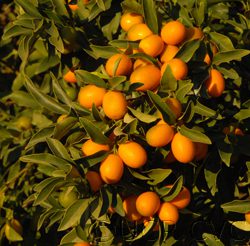One of the ways I know it’s kumquat season is that I look out into my backyard.

When I moved into my house 12 years ago, I was pleasantly surprised to find that I had an orange and a kumquat tree in my planter, and this week my kumquat tree is completely filled with fruit. This weekend, I plan to harvest them and try my hand at making Kumquat marmalade.
Kumquats are the smallest citrus fruit and are quite unique. Unique because, unlike all other citrus fruits, you do not peel them or juice them—you just eat them whole! That’s right, you pop them in your mouth, skin and all.
I learned about kumquats when I first started working for my mom on the produce market after college. My mom put me right into sales. So I came in to work every day at about 4 a.m., stood outside our stall at the produce market, and waited for the produce buyers to walk by to make the sales until about 11 a.m. Then we would go down to the basement to take inventory of what was left over from the day. And then, after lunch, I would work in the office filing paperwork and answering consumer letters. Yes, those days were long—but that’s the way you learn the business!
When January rolled around, I was assigned to sell the kumquats. They came from the farm packed in 10-pound boxes. I learned quite a few things—first of all is how to eat them. The skin is sweet and the inside is tart. So, after washing them, I would pop them in my mouth and eat them whole. By knowing the product, I was able to explain it to my customers.
The second thing I learned is that even if the kumquats are a little bit green, that’s perfectly OK. They will eventually turn a darker orange, which means the skin gets sweeter.
Finally, I learned that the kumquats should not get too cold in the refrigerator as the cold causes chill damage, and the outside skin can get kind of translucent. And that’s one of the reasons that we decided to repack those 10-pound boxes into 8-ounce consumer packages. Our first package was a green mesh bag with a recipe card and information stapled to the top.
Believe it or not, there are a few commercially available varieties of kumquats. You can tell most of them apart by their shape. Check out these pictures and see if you can tell what variety kumquat you buy next time at the store! (Photo credits: UC Riverside Citrus Variety Collection.)
The most common variety is the Nagami Kumquat—that oval-shaped bright orange fruit you know and love with thick, sweet rind and juicy, sweet-tart pulp. This variety is about 90 percent of the entire crop.

The next variety is the Nordmann Seedless Kumquats. The teardrop-shaped fruits have thick, sweet rind with juicy pulp.

Then there are the Meiwa Kumquats. The large, slightly oval fruits have very thick, smooth, sweet rinds with just a little bit of pulp.

Grown in limited quantities are the Marumi Kumquats, which are small and round with thick, medium-sweet rind and moderately juicy pulp.

And finally, the Hong Kong Kumquats are grown ornamentally. The small fruits have large seeds which pretty much make them inedible.

With Chinese New Year right around the corner, starting on February 18, you may find kumquats prominently displayed in your produce department. The kumquat tree in Cantonese is called Gam Gat Sue. The word Gam rhymes with the Cantonese word for gold and Gat rhymes with luck. In Mandarin, kumquat is called Jin Jiu, which means “golden orange.” For these reasons, kumquats are deemed auspicious for Chinese New Year, symbolizing wealth and prosperity, and presented as gifts.
I hope that you’ll give these little citrus fruits a try!
Karen






